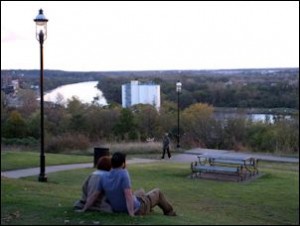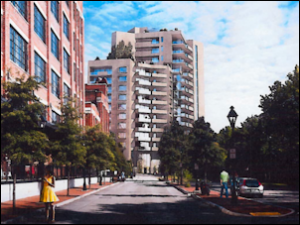by James A. Bacon
Libbie Hill Park sits on the crest of a hill overlooking the James River. On that spot in 1737 William Byrd II famously looked upon the turn in the river, was struck by its resemblance to Richmond-upon-Thames outside London, and decided to give the new city founded nearby the name of Richmond. It is understandably a view that preservationists want to protect.
But the Richmond Planning Commission approved Monday a special use permit to build a 16-story condominium building, The James at River Bend, just west of the view from Libby Hill Park. That decision follows approval earlier this month of an office complex on the eastern side of Libby Hill. Some conservationists are up in arms, and I sympathize. Some things are worth preserving. Yet I agree with the planning commission’s decision. Shockoe Bottom is an appropriate place for development at greater intensity.
The Richmond metropolitan region has reached a turning point. After decades of scattered, low-density growth giving the region one of the worst sprawl indexes in the country, the momentum of growth has shifted back to the urban core. Richmond’s downtown and surrounding precincts have accommodated significant population growth through the expedient of renovating an extensive stock of old warehouses, offices and industrial buildings. That strategy has been economically feasible thanks to state and federal historic tax credits. But the inventory of old industrial buildings is running low. In the future, developers will have to build taller buildings.
David White, president of Historic Housing LLC, explained during the permit hearing that he could not finance the project without the building height and the views that commanded high condominium prices. “I can’t make the numbers word,” he said. “The only way I can afford to build the build is to get the dollars that come from the height.”
Richmond, Henrico County and Chesterfield County all have to come to terms with the prospect of higher density development and taller buildings. It is the natural order of metropolitan evolution and cannot be avoided except at great cost. Richmond’s urban core needs higher density. Condominium towers generate high tax revenues without major offsetting infrastructure costs. They also provide the density needed to support the Bus Rapid Transit system that city planners want to run along Broad Street. Failure to densify the Broad Street corridor will doom BRT to economic failure and perpetual subsidies. And the alternative to building “up” is to build “out” — creating more sprawl with its voracious needs for expensive new infrastructure.
Those considerations trump the marginal impact of the condo project on the view from Libbie Park, as even the Historic Richmond Foundation agrees. The hard decision will come when someone proposes to erect a building that will blot out the river. Until that time comes, the trade-off is an easy one to make.




